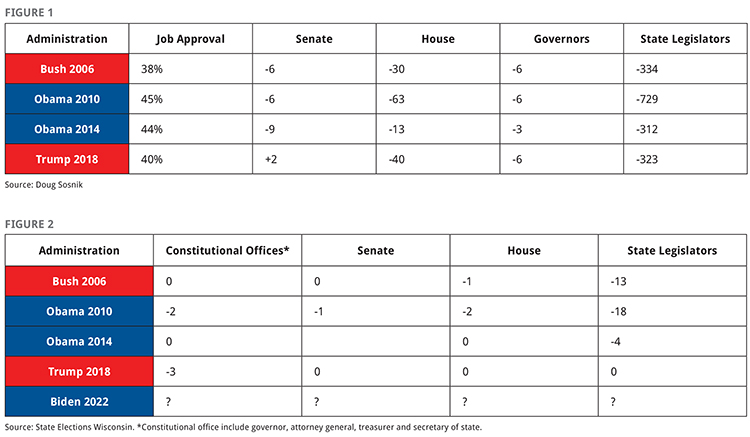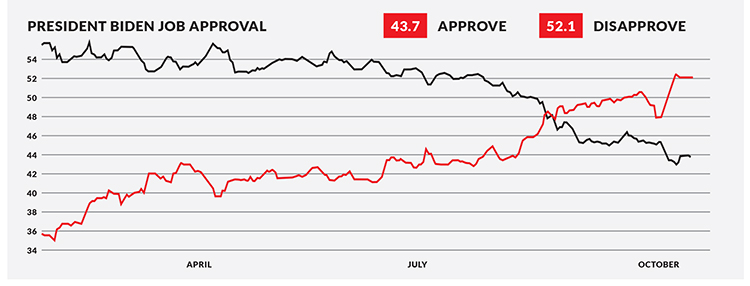In February 2021, political analyst Charlie Cook wrote a piece for the National Journal titled “The four factors that matter in predicting 2022.” The four factors included political history, exposure, environment and circumstances. Cook predicts these four factors will have significant influence over next year’s national elections.
The November 2022 midterm elections are 13 months away, and that’s an eternity in politics. Many things could happen to influence the elections in Wisconsin. For example, President Joe Biden and the Democratic Congress are locked in a fight with Republicans over taxes and spending, immigration, election integrity and COVID-19 pandemic issues. In Wisconsin, Democratic Gov. Tony Evers remains at odds with legislative Republicans over a variety of issues that include school funding, social justice reform and the state response to the coronavirus pandemic. Both national and state issues will influence voters in Wisconsin.
All this said, the four factors cited by Cook certainly apply to Wisconsin next year. Let’s take a closer look.
History
History favors the Republicans in the 2022 midterm elections nationally and in Wisconsin. American voters typically put a check on power, and the president’s party has lost House seats in almost every midterm going back to the 1930s. Since 2006, the party in power has suffered significant election losses up and down the ballot. Figure 1 illustrates national midterm election losses for federal and state elections over the last four midterms for Democrats and Republicans. In Wisconsin midterm elections, the party of the White House suffered congressional and state legislative losses as well.


Exposure
Cook defines “exposure” as the number of seats each political party must defend, particularly at the top of the ticket. In Wisconsin next year, the Democrats will have to defend five stateside constitutional offices versus only one for Republicans.
In the 2018 Wisconsin midterm elections, Democrats ran the table at the top of the ticket. They now hold — and must defend — the offices of governor, lieutenant governor, attorney general, state treasurer and the secretary of state, even though few people pay attention to the state treasurer or secretary of state. Only one partisan statewide office is held by a Republican, Sen. Ron Johnson.
This means Democrats are far more politically exposed than Republicans. And the degree of exposure is greater because Wisconsin is a true swing state, not a reliably red or blue state. Swing states, by definition, are more competitive, attract more outside spending on both sides and tend to be more susceptible to the current political environment, whichever way the political winds are blowing.
In the state Legislature, Republicans hold comfortable majorities in both the Assembly and Senate. This is where the GOP has the most exposure. The amount of exposure is difficult to project until the new legislative district lines are finalized through the redistricting process. Most insiders expect the redistricting process to be finished by early spring 2022. After that process concludes, most likely in the courts, it will be easier to see where the GOP is most exposed in legislative districts.
Environment
Cook notes, “Midterm elections are usually referenda on the sitting president or the party in control, so whether a president and his party have a tailwind or a headwind is very important.”
Most pollsters will point to presidential job approval as a key metric to determine which way the voters are trending. It’s not the only metric, but generally the best one to watch.
When President Biden was sworn into office in January, his job approval rating was 55.8% with a disapproval rating of 35.5% (+20.3%) in the Real Clear Politics average. By October 9, his numbers stood at 43.4% approve and 50.3% disapprove (-6.9%).
In the August 2021 Marquette Law School poll of Wisconsin voters, Biden’s job approval numbers stood at 49% approve, 46% disapprove and 4 % undecided. As you can see, President Biden’s job approval numbers are down in both national and state polling.
Sean Trende, senior elections analyst for Real Clear Politics, had this to say about Biden’s job approval ratings moving from positive to negative territory: “Abysmal elections for parties in power have occurred when the president was generally unpopular: witness 1994, 2010 and 2018. Thus, the trend in President Biden’s job approval has to be concerning for Democrats.”
Circumstances
Cook defines “circumstances” as “relatively unique attributes or situations that may make an election deviate from historical trends.”
As it stands now, some 13 months before the 2022 midterm elections, one issue is being discussed by political prognosticators as significant enough to influence next year’s elections from historical trends: the Mississippi 15-week abortion ban case currently under review by the U.S. Supreme Court.
Bill Scher, contributing editor to Politico magazine, highlighted the pending case: “The Supreme Court has already decided to review Mississippi’s stayed 15-week abortion ban, and will likely issue its ruling in late June or early July, about four months before the midterms. Upholding the law would require either overturning Roe v. Wade or severely scaling back its enshrinement of abortion rights.”
If the Supreme Court overturns Roe v. Wade, it’s the kind of issue that could cause election results that are contrary to historical trends. Regardless of whether one is pro-choice or pro-life, it’s the kind of issue that generates passion on both sides, and it could impact the midterm elections in unpredictable ways.
Joe Murray is Director of Political and Governmental Affairs for the WRA.